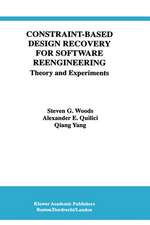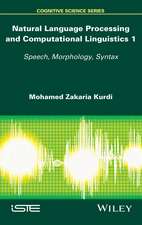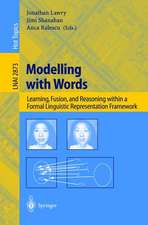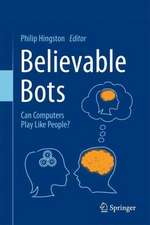Modelling and Reasoning with Vague Concepts: Studies in Computational Intelligence, cartea 12
Autor Jonathan Lawryen Limba Engleză Hardback – 11 ian 2006
| Toate formatele și edițiile | Preț | Express |
|---|---|---|
| Paperback (1) | 644.48 lei 6-8 săpt. | |
| Springer Us – 25 noi 2014 | 644.48 lei 6-8 săpt. | |
| Hardback (1) | 652.04 lei 6-8 săpt. | |
| Springer Us – 11 ian 2006 | 652.04 lei 6-8 săpt. |
Din seria Studies in Computational Intelligence
- 20%
 Preț: 449.37 lei
Preț: 449.37 lei - 20%
 Preț: 1158.26 lei
Preț: 1158.26 lei - 20%
 Preț: 986.66 lei
Preț: 986.66 lei - 20%
 Preț: 1452.76 lei
Preț: 1452.76 lei - 20%
 Preț: 168.78 lei
Preț: 168.78 lei - 20%
 Preț: 1291.10 lei
Preț: 1291.10 lei - 18%
 Preț: 1112.30 lei
Preț: 1112.30 lei - 20%
 Preț: 565.39 lei
Preț: 565.39 lei - 20%
 Preț: 649.28 lei
Preț: 649.28 lei - 20%
 Preț: 1047.73 lei
Preț: 1047.73 lei - 20%
 Preț: 1578.96 lei
Preț: 1578.96 lei - 20%
 Preț: 643.50 lei
Preț: 643.50 lei - 20%
 Preț: 657.49 lei
Preț: 657.49 lei - 20%
 Preț: 993.28 lei
Preț: 993.28 lei - 20%
 Preț: 990.80 lei
Preț: 990.80 lei - 20%
 Preț: 989.96 lei
Preț: 989.96 lei - 20%
 Preț: 1165.69 lei
Preț: 1165.69 lei - 20%
 Preț: 1444.52 lei
Preț: 1444.52 lei - 20%
 Preț: 1041.96 lei
Preț: 1041.96 lei - 20%
 Preț: 1047.73 lei
Preț: 1047.73 lei - 20%
 Preț: 1046.06 lei
Preț: 1046.06 lei - 18%
 Preț: 2500.50 lei
Preț: 2500.50 lei - 20%
 Preț: 989.13 lei
Preț: 989.13 lei - 20%
 Preț: 1165.69 lei
Preț: 1165.69 lei - 20%
 Preț: 1164.05 lei
Preț: 1164.05 lei - 20%
 Preț: 1042.79 lei
Preț: 1042.79 lei - 20%
 Preț: 1460.19 lei
Preț: 1460.19 lei - 18%
 Preț: 1403.52 lei
Preț: 1403.52 lei - 18%
 Preț: 1124.92 lei
Preț: 1124.92 lei - 20%
 Preț: 1039.47 lei
Preț: 1039.47 lei - 20%
 Preț: 1008.11 lei
Preț: 1008.11 lei - 20%
 Preț: 1045.25 lei
Preț: 1045.25 lei - 20%
 Preț: 1275.42 lei
Preț: 1275.42 lei - 20%
 Preț: 1040.32 lei
Preț: 1040.32 lei - 20%
 Preț: 988.32 lei
Preț: 988.32 lei - 20%
 Preț: 1169.79 lei
Preț: 1169.79 lei - 20%
 Preț: 1162.37 lei
Preț: 1162.37 lei - 20%
 Preț: 1059.26 lei
Preț: 1059.26 lei - 20%
 Preț: 1164.05 lei
Preț: 1164.05 lei - 20%
 Preț: 1166.52 lei
Preț: 1166.52 lei - 20%
 Preț: 1459.38 lei
Preț: 1459.38 lei - 18%
 Preț: 1005.74 lei
Preț: 1005.74 lei - 20%
 Preț: 997.38 lei
Preț: 997.38 lei - 20%
 Preț: 1055.94 lei
Preț: 1055.94 lei - 20%
 Preț: 1284.47 lei
Preț: 1284.47 lei - 20%
 Preț: 994.08 lei
Preț: 994.08 lei - 20%
 Preț: 1048.72 lei
Preț: 1048.72 lei - 20%
 Preț: 1066.02 lei
Preț: 1066.02 lei - 20%
 Preț: 943.78 lei
Preț: 943.78 lei - 20%
 Preț: 1173.10 lei
Preț: 1173.10 lei
Preț: 652.04 lei
Preț vechi: 815.05 lei
-20% Nou
Puncte Express: 978
Preț estimativ în valută:
124.81€ • 135.61$ • 104.91£
124.81€ • 135.61$ • 104.91£
Carte tipărită la comandă
Livrare economică 21 aprilie-05 mai
Preluare comenzi: 021 569.72.76
Specificații
ISBN-13: 9780387290560
ISBN-10: 0387290567
Pagini: 246
Ilustrații: XXV, 246 p.
Dimensiuni: 155 x 235 x 18 mm
Greutate: 0.6 kg
Ediția:2006
Editura: Springer Us
Colecția Springer
Seria Studies in Computational Intelligence
Locul publicării:New York, NY, United States
ISBN-10: 0387290567
Pagini: 246
Ilustrații: XXV, 246 p.
Dimensiuni: 155 x 235 x 18 mm
Greutate: 0.6 kg
Ediția:2006
Editura: Springer Us
Colecția Springer
Seria Studies in Computational Intelligence
Locul publicării:New York, NY, United States
Public țintă
ResearchCuprins
Vague Concepts and Fuzzy Sets.- Label Semantics.- Multi-Dimensional and Multi-Instance Label Semantics.- Information from Vague Concepts.- Learning Linguistic Models from Data.- Fusing Knowledge and Data.- Non-Additive Appropriateness Measures.
Textul de pe ultima copertă
Vagueness is central to the flexibility and robustness of natural language descriptions. Vague concepts are robust to the imprecision of our perceptions, while still allowing us to convey useful, and sometimes vital, information. The study of vagueness in Artificial Intelligence (AI) is therefore motivated by the desire to incorporate this robustness and flexibility into intelligent computer systems. Such a goal, however, requires a formal model of vague concepts that will allow us to quantify and manipulate the uncertainty resulting from their use as a means of passing information between autonomous agents.
This volume outlines a formal representation framework for modelling and reasoning with vague concepts in Artificial Intelligence. The new calculus has many applications, especially in automated reasoning, learning, data analysis and information fusion. This book gives a rigorous introduction to label semantics theory, illustrated with many examples, and suggests clear operational interpretations of the proposed measures. It also provides a detailed description of how the theory can be applied in data analysis and information fusion based on a range of benchmark problems.
This volume outlines a formal representation framework for modelling and reasoning with vague concepts in Artificial Intelligence. The new calculus has many applications, especially in automated reasoning, learning, data analysis and information fusion. This book gives a rigorous introduction to label semantics theory, illustrated with many examples, and suggests clear operational interpretations of the proposed measures. It also provides a detailed description of how the theory can be applied in data analysis and information fusion based on a range of benchmark problems.
Caracteristici
Gives a "semantic" treatment of vague concepts in AI emphasizing the operational interpretation of the measures proposed Brings a new perspective on modeling vague concepts by focusing on the decision problem associated with identifying which labels can be appropriately use to describe a particular instance Provides a coherent theory of the probability of vague expressions useful when incorporating such descriptions into high-level models Demonstrates how this framework can be applied in data analysis to infer effective and informative models Includes supplementary material: sn.pub/extras





















